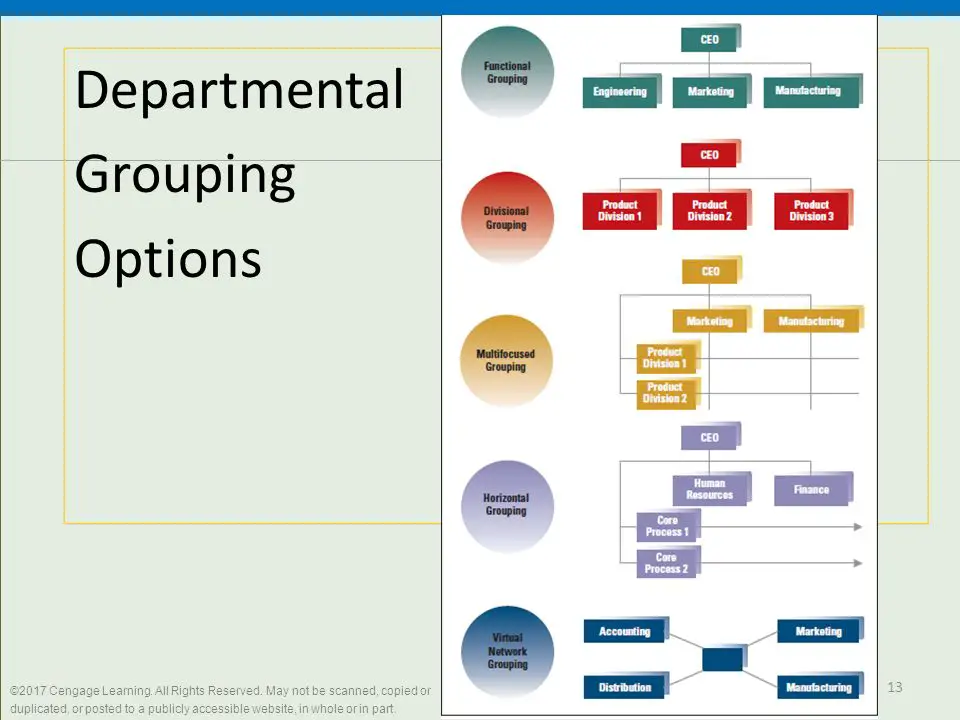Organization Design Alternatives
The overall design of organization structure indicates three things:
- required work activities,
- reporting relationships, and
- departmental groupings.
Required Work Activities
Departments are created to perform tasks considered strategically important to the company.
In a typical manufacturing company, for example, work activities fall into a range of functions that help the organization accomplish its goals, such as human resource department to recruit and train employees, a purchasing department to obtain supplies and raw materials, a production department to build products, and a sales department to sell products.
As organizationsOpens in new window grow larger and more complex, managers find that more functions need to be performed.
OrganizationsOpens in new window typically define new positions, departments, or divisions as a way to accomplish new tasks deemed valuable by the organization. For example, British oil giant BP added a new safety division in the wake of the Deepwater Horizon oil spill.
Reporting Relationships
Once required work activities and departments are defined, the next question is how these activities and departments should fit together in the organizational hierarchy.
Reporting relationships, often called the chain of command, are represented by vertical lines on an organization chart.
The chain of command should be an unbroken line of authority that links all persons in an organization and shows who reports to whom.
In a large organization such as General Electric, BP, L’Oreal, or Microsoft, 100 or more charts might be needed to identify reporting relationships among thousands of employees.
The definition of departments and the drawing of reporting relationships define how employees are to be grouped into departments.
Departmental Grouping Options
Options for departmental grouping, including:
- functional grouping,
- divisional grouping,
- multifocused grouping,
- horizontal grouping, and
- virtual network grouping.
These are illustrated in Figure X-5.
 Figure X-5 Departmental Grouping Options | Credit — SlidePlayer Opens in new window
Figure X-5 Departmental Grouping Options | Credit — SlidePlayer Opens in new window
In an organization with a high level of relational coordination, people share information freely across departmental boundaries, and people interact on a continuous basis to share knowledge and solve problems.
Coordination is carried out through a web of ongoing positive relationships rather than because of formal coordination roles or mechanisms. Employees coordinate and collaborate directly with each other across units.
Building relational coordination into the fabric of the organization requires the active role of managers.
Managers invest in training people in the skills needed to interact with one another and resolve cross-functional conflictsOpens in new window, build trust and credibility by showing they care about employees, and intentionally foster relationships based on shared goals rather than emphasizing goals of the separate departments.
People are given freedom from strict work rules so they have the flexibility to interact and contribute wherever they are needed, and rewards are based on team efforts and accomplishments.
Frontline supervisors have small spans of control so they can develop close working relationships with subordinates and coach and mentor employees.
Managers also create specific cross-functional roles that promote coordination across boundaries.
Departmental grouping affects employees because they share a common supervisor and common resources, are jointly responsible for performance, and tend to identify and collaborate with one another.
- Functional Grouping
Functional grouping places together employees who perform similar functions or work processes or who bring similar knowledge and skills to bear. For example, all marketing people work together under the same supervisor, as do all manufacturing employees, all human resources people, and all engineers.
For an Internet company, all the people associated with maintaining the website might be grouped together in one department. In a scientific research film, all chemists may be grouped in a department different from biologists because they represent different disciplines.
- Divisional Grouping
Divisional grouping means people are organized according to what the organization produces. All the people required to produce toothpaste—including personnel in marketing, manufacturing, and sales—are grouped together under one executive.
In huge corporations, such as Time Warner Corporation, some product or service lines may represent independent businesses, such as Warner Brothers Entertainment (movies and videos), Time Inc. (publisher of magazines such as Sports Illustrated, Time, and People), and Turner Broadcasting (cable television networks).
- Multifocused Grouping
Multifocused grouping means an organization embraces two or more structural grouping alternatives simultaneously. These structural forms are often called matrix or hybrid.
In matrix groupingOpens in new window, an organization may need to group by function and product division simultaneously or might need to combine characteristics of several structural options.
- Horizontal Grouping
Horizontal grouping means employees are organized around core work processes, the end-to-end work, information, and material flows that provide value directly to customers. All the people who work on a core process are brought together in a group rather than being separated into functional departments.
At field offices of the U.S. Occupational Safety and Health Administration, for example, teams of workers representing various functions respond to complaints.
- Virtual Network Grouping
With virtual network grouping, the organization is a loosely connected cluster of separate components. In essence, departments are separate organizations that are electronically connected for the sharing of information and completion of tasks. Departments can be spread all over the world rather than located together in one geographic location.
- Holacracy Team Grouping
Holacracy team groupingOpens in new window is the most recent approach to departmental grouping. With this grouping, the entire organization is made up of self-managing teams that include the people needed to accomplish a specific task or activity.
The organization forms described in Figure X-5 provide the overall options within which a company’ organization chart is drawn and the detailed structure is designed.
Each structural design alternative has significant strengths and weaknesses, to which we now turn.
| Remember This |
|---|
|
You Might Also Like:
- Research data for this work have been adapted from the manual:
- Organization Theory & Design By Richard L. Daft

